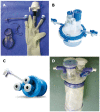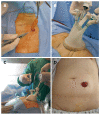Overview of single-port laparoscopic surgery for colorectal cancers: past, present, and the future
- PMID: 24574772
- PMCID: PMC3921551
- DOI: 10.3748/wjg.v20.i4.997
Overview of single-port laparoscopic surgery for colorectal cancers: past, present, and the future
Abstract
Single-port laparoscopic surgery (SPLS) is implemented through a tailored minimal single incision through which a number of laparoscopic instruments access. Introduction of operation-customized port system, utilization of a camera without a separate external light, and instruments with different lengths has brought the favorable environment for SPLS. However, performing SPLS still creates several hardships compared to multiport laparoscopic surgery; a single-port system inevitably leads to clashing of surgical instruments due to crowding. To overcome such difficulties, investigators has developed novel concepts and maneuvers, including the concept of inverse triangulation and the maneuvers of pivoting, spreading out dissection, hanging suture, and transluminal traction. The final destination of SPLS is expected to be a completely seamless operation, maximizing the minimal invasiveness. Specimen extraction through the umbilicus can undermine cosmesis by inducing a larger incision. Therefore, hybrid laparoscopic technique, which combined laparoscopic surgical technique with natural orifice specimen extraction (NOSE)--i.e., transvaginal or transanal route-, has been developed. SPLS and NOSE seemed to be the best combination in pursuit of minimal invasiveness. In the near future, robotic SPLS with natural orifice transluminal endoscopic surgery's way of specimen extraction seems to be pursued. It is expected to provide a completely or nearly complete seamless operation regardless of location of the lesion in the abdomen.
Keywords: Colectomy; Colorectal neoplasms; Laparoscopy; Natural orifice endoscopic surgery; Single-port laparoscopic surgery.
Figures






Similar articles
-
Totally laparoscopic anterior resection with transvaginal assistance and transvaginal specimen extraction: a technique for natural orifice surgery combined with reduced-port surgery.Surg Endosc. 2013 Dec;27(12):4734-40. doi: 10.1007/s00464-013-3120-3. Epub 2013 Aug 16. Surg Endosc. 2013. PMID: 23949481 Free PMC article.
-
Success rate of natural orifice specimen extraction after laparoscopic colorectal resections.Tech Coloproctol. 2017 Apr;21(4):295-300. doi: 10.1007/s10151-017-1611-2. Epub 2017 Apr 26. Tech Coloproctol. 2017. PMID: 28447167
-
New trends in colorectal surgery: single port and natural orifice techniques.World J Gastroenterol. 2014 Dec 28;20(48):18104-20. doi: 10.3748/wjg.v20.i48.18104. World J Gastroenterol. 2014. PMID: 25561780 Free PMC article. Review.
-
Natural orifice specimen extraction using prolapsing technique in single-incision laparoscopic colorectal resections for colorectal cancers.Asian J Endosc Surg. 2014 Jan;7(1):85-8. doi: 10.1111/ases.12063. Asian J Endosc Surg. 2014. PMID: 24450353
-
Single-incision laparoscopic colorectal surgery for cancer: state of art.World J Gastroenterol. 2014 May 28;20(20):6073-80. doi: 10.3748/wjg.v20.i20.6073. World J Gastroenterol. 2014. PMID: 24876729 Free PMC article. Review.
Cited by
-
Efficacy and safety of reduced-port laparoscopic surgery versus conventional laparoscopic surgery for colorectal cancer.BMC Cancer. 2025 Feb 1;25(1):187. doi: 10.1186/s12885-025-13585-3. BMC Cancer. 2025. PMID: 39893372 Free PMC article.
-
Procedural and post-operative complications associated with laparoscopic versus open abdominal surgery for right-sided colonic cancer resection: A systematic review and meta-analysis.Medicine (Baltimore). 2020 Oct 2;99(40):e22431. doi: 10.1097/MD.0000000000022431. Medicine (Baltimore). 2020. PMID: 33019422 Free PMC article.
-
The evolution of cancer surgery and future perspectives.Nat Rev Clin Oncol. 2015 Feb;12(2):115-24. doi: 10.1038/nrclinonc.2014.191. Epub 2014 Nov 11. Nat Rev Clin Oncol. 2015. PMID: 25384943 Review.
-
Comparison of single-port and conventional laparoscopic abdominoperineal resection.J Minim Access Surg. 2018 Jan-Mar;14(1):27-32. doi: 10.4103/jmas.JMAS_38_17. J Minim Access Surg. 2018. PMID: 28782746 Free PMC article.
-
Da Vinci single-port robotic system current application and future perspective in general surgery: A scoping review.Surg Endosc. 2024 Sep;38(9):4814-4830. doi: 10.1007/s00464-024-11126-w. Epub 2024 Aug 7. Surg Endosc. 2024. PMID: 39110221 Free PMC article.
References
-
- Clinical Outcomes of Surgical Therapy Study Group. A comparison of laparoscopically assisted and open colectomy for colon cancer. N Engl J Med. 2004;350:2050–2059. - PubMed
-
- Fleshman J, Sargent DJ, Green E, Anvari M, Stryker SJ, Beart RW, Hellinger M, Flanagan R, Peters W, Nelson H. Laparoscopic colectomy for cancer is not inferior to open surgery based on 5-year data from the COST Study Group trial. Ann Surg. 2007;246:655–662; discussion 662-664. - PubMed
-
- Guillou PJ, Quirke P, Thorpe H, Walker J, Jayne DG, Smith AM, Heath RM, Brown JM. Short-term endpoints of conventional versus laparoscopic-assisted surgery in patients with colorectal cancer (MRC CLASICC trial): multicentre, randomised controlled trial. Lancet. 2005;365:1718–1726. - PubMed
-
- Hewett PJ, Allardyce RA, Bagshaw PF, Frampton CM, Frizelle FA, Rieger NA, Smith JS, Solomon MJ, Stephens JH, Stevenson AR. Short-term outcomes of the Australasian randomized clinical study comparing laparoscopic and conventional open surgical treatments for colon cancer: the ALCCaS trial. Ann Surg. 2008;248:728–738. - PubMed
Publication types
MeSH terms
LinkOut - more resources
Full Text Sources
Other Literature Sources
Medical
Miscellaneous

